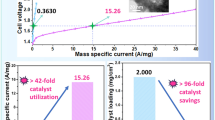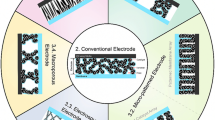Abstract
A non-enzymatic glucose biofuel cell (GBFCs) with high-power density and adequate open-circuit potential in physiological environment is based on the improved hydrogen template electrodeposition of the platinum-nickel (PtNi) nanoalloys (the third step adopted a potential-step electrochemical synthesis instead of the conventional method). The morphology tests demonstrate that the highly porous PtxNi1-x nanoalloys exhibit broader pore-size distribution and larger specific electrochemically active surface area than the Pt monometallic nanostructures. Combined with cyclic voltammograms, polarization parameters and cell tests, degradation behavior measurements prove that the nanoalloy products display the excellent long-term stability and high electrocatalytic activity. Controlling the preparation conditions of the highly porous PtxNi1-x nanoalloys could control the morphology and nanostructure of the as-synthesis nanoalloys in order to improve the catalytic performance of these nanoalloys, which grants it great potentialities for controllable synthesis of electrocatalysts in the application of GBFCs.
Graphical abstract

Description The highly porous platinum nickel nanoalloys are applied as both anode and cathode in the non-enzymatic glucose biofuel cell with high-power density and adequate open-circuit potential in physiological environment.









Similar content being viewed by others
References
Halámková L, Halámek J, Bocharova V, Szczupak A, Alfonta L, Katz E (2012) Implanted biofuel cell operating in a living snail. J Am Chem Soc 134:5040–5043
Oncescu V, Erickson D (2013) High volumetric power density, non-enzymatic, glucose fuel cells. Sci Rep 3:1226–1231
Stahl SS (2005) Palladium-catalyzed oxidation of organic chemicals with O2. Science 16:1824–1826
Rong L, Yang C, Qian Q, Xia X (2007) Study of the nonenzymatic glucose sensor based on highly dispersed Pt nanoparticles supported on carbon nanotubes. Talanta 72:819–824
Zhao Y, Fan LZ, Zhong HZ, Li YF, Yang SH (2007) Platinum nanoparticle clusters immobilized on multiwalled carbon nanotubes: electrodeposition and enhanced electrocatalytic activity for methanol oxidation. Adv Funct Mater 17:1537–1541
Ryu J, Kim H, Hahn HT, Lashmore D (2010) Intense pulsed light induced platinum–gold alloy formation on carbon nanotubes for non-enzymatic glucose detection. Biosens Bioelectron 26:602–607
Ze H, Chen X, Wang XT, Wang YH, Li JF (2021) Molecular insight of the critical role of Ni in Pt-based nanocatalysts for improving the oxygen reduction reaction probed using an in situ SERS borrowing strategy. J Am Chem Soc 143(3):1318–1322
Vassilyev YB, Khazova OA, Nikolaeva NN (1985) Kinetics and mechanism of glucose electrooxidation on different electrode-catalysts: Part I. Adsorption and oxidation on platinum. J Electroanal Chem Interfacial Electrochem 196:105–125
Wang ZB, Zuo PJ, Wang GJ, Du CY, Yin GP (2008) Effect of Ni on PtRu/C catalyst performance for ethanol electrooxidation in acidic medium. J Phys Chem C 112:6582–6587
Carpenter MK, Moylan TE, Kukreja RS, Atwan MH, Tessema MM (2012) Solvothermal synthesis of platinum alloy nanoparticles for oxygen reduction electrocatalysis. J Am Chem Soc 134:8535–8542
Zhu C, Guo S, Dong S (2012) PdM (M=Pt, Au) bimetallic alloy nanowires with enhanced electrocatalytic activity for electro-oxidation of small molecules. Adv Mater 24:2326–2331
Navaee A, Narimani M, Korani A, Ahmadi R, Salimi A, Soltanian S (2016) Bimetallic Fe15Pt85 nanoparticles as an effective anodic electrocatalyst for non-enzymatic glucose/oxygen biofuel cell. Electrochim Acta 208:325–333
Niu X, Lan M, Zhao H, Chen C (2013) Highly sensitive and selective nonenzymatic detection of glucose using three-dimensional porous nickel nanostructures. Anal Chem 85:3561–3569
Cui C, Gan L, Li H, Yu S, Heggen M, Strasser P (2012) Octahedral PtNi nanoparticle catalysts: exceptional oxygen reduction activity by tuning the alloy particle surface composition. Nano Lett 12:5885–5889
Karimi-Maleh H, Cellat K, Arıkan K, Savk A, Karimi F, Sen F (2020) Palladium–nickel nanoparticles decorated on Functionalized-MWCNT for high precision non-enzymatic glucose sensing. Mater Chem Phys 250:123042–123047
Zhao Y, Fan LZ, Zhang Y, Que QM, Hong B (2015) Three-dimensional PtxNi1−x nanoclusters supported on multiwalled carbon nanotubes in enzyme-free glucose biofuel cells. J Power Sour 296:30–39
Habrioux A, Servat K, Tingry S, Kokoh KB (2009) Enhancement of the performances of a single concentric glucose/O2 biofuel cell by combination of bilirubin oxidase/Nafion cathode and Au–Pt anode. Electrochem Commun 11:111–113
Sehit E, Altintas Z (2020) Significance of nanomaterials in electrochemical glucose sensors: an updated review (2016–2020). Biosens Bioelectron 159:112165–112182
du Toit H, Lorenzo MD (2014) Electrodeposited highly porous gold microelectrodes for the direct electrocatalytic oxidation of aqueous glucose. Sens Actuators B 192:725–729
Kloke A, Kohler C, Zengerle R, Kerzenmacher S (2012) Porous platinum electrodes fabricated by cyclic electrodeposition of PtCu alloy: application to implantable glucose fuel cells. J Phys Chem C 116:19689–19698
Oncescu V, Erickson D (2011) A microfabricated low cost enzyme-free glucose fuel cell for powering low-power implantable devices. J Power Sour 196:9169–9175
Kerzenmacher S, Kräling U, Metz T, Zengerle R, von Stetten F (2011) A potentially implantable glucose fuel cell with Raney-platinum film electrodes for improved hydrolytic and oxidative stability. J Power Sour 196:1264–1272
Frei M, Erben J, Martin J, Zengerle R, Kerzenmacher S (2017) Nanofiber-deposited porous platinum enables glucose fuel cell anodes with high current density in body fluid. J Power Sour 362:168–173
Li Y, Jia WZ, Song YY, Xia XH (2007) Superhydrophobicity of 3D porous copper films prepred using the hydrogen bubble dynamic template. Chem Mater 19:5758–5764
Kohler C, Frei M, Zengerle R, Kerzenmacher S (2014) Performance loss of a Pt-based implantable glucose fuel cell in simulated tissue and cerebrospinal fluids. Chem Electro Chem 1:1895–1900
Gan L, Heggen M, O’Malley R, Theobald B, Strasser P (2013) Understanding and controlling nanoporosity formation for improving the stability of bimetallic fuel cell catalysts. Nano Lett 13:1131–1138
Plowman BJ, Jones LA, Bhargava SK (2015) Building with bubbles: the formation of high surface area honeycomb-like films via hydrogen bubble templated electrodeposition. Chem Commun 51:4331–4346
Zhao Y, Fan LZ, Hong B, Zhang Y, Zhang MS, Que QM, Ji JY (2016) Three-dimensional porous palladium foam-like nanostructures as electrocatalysts for glucose biofuel cells. Energy Technol 4:249–255
Zhang H, Yi B, Jiang S, Zeng Y, Shao Z (2017) Three-dimensional assembly of PtNi alloy nanosticks with enhanced electrocatalytic activity and ultrahigh stability for the oxygen reduction reaction. Chem Electro Chem 4:1436–1442
Nassr ABAA, Sinev I, Grunert W, Bron M (2013) PtNi supported on oxygen functionalized carbon nanotubes: in depth structural characterization and activity for methanol electrooxidation. Appl Catal B 142:849–860
Shao M, Peles A, Shoemaker K (2011) Electrocatalysis on platinum nanoparticles: particle size effect on oxygen reduction reaction activity. Nano Lett 11(9):3714–3719
Xu Z, Zhang H, Zhong H (2012) Effect of particle size on the activity and durability of the Pt/C electrocatalyst for proton exchange membrane fuel cells. Appl Catal, B 111:264–270
Tritsaris GA, Greeley J, Rossmeisl J (2011) Atomic-scale modeling of particle size effects for the oxygen reduction reaction on Pt. Catal Lett 141(7):909–913
Lezanska M, Olejniczak A, Lukaszewicz JP (2018) Hierarchical porous carbon templated with silica spheres of a diameter of 14 nm from pure chitosan or a chitosan/ZnCl2 solution. J Porous Mater 25:1633–1648
Zhang Y, Sun J, Hou B, Hu Y (2011) Performance improvement of air-cathode single-chamber microbial fuel cell using a mesoporous carbon modified anode. J Power Sour 196:7458–7464
An L, Zhao TS, Shen SY, Wu QX, Chen R (2011) Alkaline direct oxidation fuel cell with non-platinum catalysts capable of converting glucose to electricity at high power output. J Power Sour 196:186–190
Scott K, Yu E, Vlachogiannopoulos G, Shivare M, Duteanu N (2008) Performance of a direct methanol alkaline membrane fuel cell. J Power Sour 175:452–457
Basu D, Basu S (2012) Performance studies of Pd–Pt and Pt–Pd–Au catalyst for electro-oxidation of glucose in direct glucose fuel cell. Inter J Hydrog Energy 37:4678–4684
Yang L, Zhang Y, Chu M, Deng W, Tan Y, Ma M, Su X, Xie Q, Yao S (2014) Facile fabrication of network film electrodes with ultrathin Au nanowires for nonenzymatic glucose sensing and glucose/O2 fuel cell. Biosens Bioelectron 52:105–110
Li Z, Li G, Wu Z, Jiao S, Hu Z (2019) Cobalt sulfides/carbon nanohybrids: a novel biocatalyst for nonenzymatic glucose biofuel cells and biosensors. RSC Adv 9:32898–32905
Chu TF, Rajendran R, Kuznetsova I, Wang GJ (2020) High-power, non-enzymatic glucose biofuel cell based on a nano/micro hybrid-structured Au anode. J Power Sour 453:227844–227850
Sheng Q, Mei H, Wu H, Zhang X, Wang S (2014) PtxNi/C nanostructured composites fabricated by chemical reduction and their application in non-enzymatic glucose sensors. Sens Actuators B 203:588–595
Santos LGRA, Oliveria CHF, Moraes IR, Ticianelli EA (2006) Oxygen reduction reaction in acid medium on Pt–Ni/C prepared by a microemulsion method. J Electroanal Chem 596:141–148
da Silva FT, Dalmazzo VA, Becker MR, de Souza MO, de Souza RF, Martini EMA (2014) Effect of Ni proportion on the performance of proton exchange membrane fuel cells using PtNi/C electrocatalysts. Ionics 20:381–388
Acknowledgements
This work is financially supported by the Fundamental Research Funds for the Central Universities (202051011), the National Natural Science Foundation of China (41877176) and the National Natural Science Foundation of China (21878280).
Author information
Authors and Affiliations
Corresponding author
Ethics declarations
Conflict of interest
The authors declared that they have no conflicts of interest to this work. We declare that we do not have any commercial or associative interest that represents a conflict of interest in connection with the work submitted. All of the authors have complied with Journal of Materials Science's ethical requirements: this work has not been published previously nor is it being considered by any other peer-reviewed journal. Its publication is approved by all authors and tacitly or explicitly by the responsible authorities where the work was carried out. If accepted, it will not be published elsewhere in the same form, in English or in any other language, without the written consent of the Publisher. Our study does not involve human subjects.
Additional information
Handling Editor: Annela M. Seddon.
Publisher's Note
Springer Nature remains neutral with regard to jurisdictional claims in published maps and institutional affiliations.
Supplementary Information
Below is the link to the electronic supplementary material.
Rights and permissions
About this article
Cite this article
Zhao, Y., Tian, L., Fan, Y. et al. Non-enzymatic glucose biofuel cells based on highly porous PtxNi1-x nanoalloys. J Mater Sci 56, 13066–13082 (2021). https://doi.org/10.1007/s10853-021-06157-w
Received:
Accepted:
Published:
Issue Date:
DOI: https://doi.org/10.1007/s10853-021-06157-w




